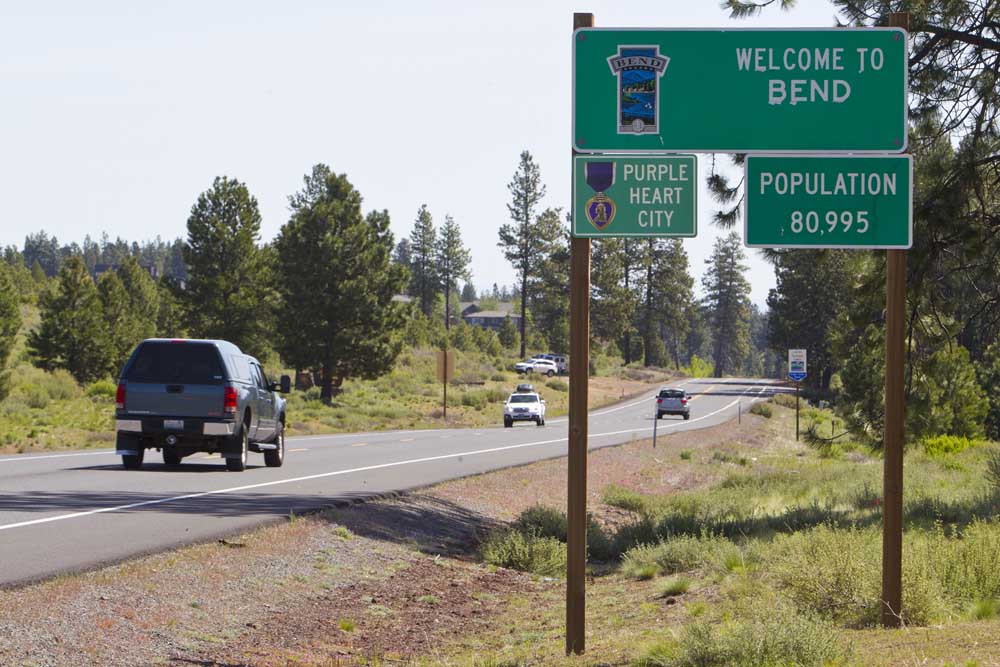Bend sees progress toward a greener city
Published 5:24 am Wednesday, October 4, 2017

- The Welcome To Bend sign, visible while approaching Bend on Century Drive. (Andy Tullis/The Bulletin)
A year after Bend approved its climate change resolution, city staff hope recent success reducing electricity usage in municipal buildings will build momentum for a communitywide climate action plan.
Bend’s climate resolution calls for reducing Bend’s fossil fuel use 40 percent and reaching carbon neutrality in municipal facilities by 2030. Small changes between 2013 and 2016 in city buildings reduced electricity use by 11.5 percent and saved the city about $30,000 on electrical bills, which Bend Senior Policy Analyst Gillian Ockner said bodes well for energy-efficiency efforts.
Trending
“With existing budgets and existing commitments to facility improvement, we were able to achieve this,” Ockner said. “We really see that there is value here because we only had to do small adjustments.”
Energy savings came through facility improvement projects the city was already doing, she said, and included common energy-saving recommendations like replacing inefficient lightbulbs with LEDs. Making sure lights, computer monitors and heating and air-conditioning were off when people weren’t in the building also helped, Ockner said.
These energy reductions are small in the scale of the city’s usage — government buildings make up about 20 percent of the city of Bend’s total electricity and natural gas usage, meaning these energy-saving measures represent just a 2.3 percent cut in total usage. But a strategic energy management plan that will be developed in the next two years aims to save more energy and reduce Bend’s effect on climate change.
The vast majority of Bend’s energy use occurs at its water filtration and wastewater treatment plants, and Ockner said finding ways to make the two plants more energy-efficient will be a major focus. The new sewer line under 27th Street also is expected to help because it relies on gravity, not pump stations, to move sewage to the wastewater treatment plant.
The city is now seeking bids from energy service companies to audit the city’s energy use and analyze how much energy-saving measures would cost. The same company would develop and implement those measures. Bids close Oct. 25.
Bend’s climate action plan is expected to cost about $175,000 during each of the next two years. The city should learn in November whether it will receive a $50,000 grant from Partners for Places, a private group that provides grants to communities. The Oregon Community Foundation would match that grant.
Trending
During the two-year budget cycle that began in July, the city of Bend allocated a total of $99,000 to the Community Climate Action Plan. This money all comes from revolving loans created by the American Recovery and Reinvestment Act of 2009 and could only be spent on investing in energy efficiency — meaning none of the money used for the climate plan could have been used for road projects or other city services.
The Environmental Center, a Bend-based nonprofit organization that focuses on sustainability, is raising the remaining $25,000 through a crowdfunding site. The group’s deadline is Saturday, and it has a little more than $500 to go.
Environmental Center Executive Director Mike Riley said it was important to look at ways to encourage Bend residents to make voluntary changes, instead of forcing them to adhere to new requirements. One example would be finding incentives for developers to make new buildings ready for solar panels, he said.
Some of the money Bend received in the 2009 stimulus package and repurposed for its climate action plan could have been used for those incentives. Non-monetary incentives, such as giving developers building energy-efficient homes priority in permit queues, could work just as well, city Councilor Nathan Boddie said.
“I don’t even think we would have to use money,” Boddie said. “We could use other things that are incentives. In talking to folks in the community, people want to put these on their homes because it saves them money.”
As a growing city, Bend has other opportunities to reduce its impact on the environment by building in a way that allows people to access services without relying on cars, said Sally Russell, mayor pro tem.
“There are all these opportunities in terms of where we site our schools, how we get our children to schools, the opportunity areas where we’re beginning to look at siting services for the people who live so they can access those services without driving around,” she said.
With the Trump administration’s announced withdrawal from the Paris climate accords and rollbacks of various Obama-era environmental regulations, it’s up to local governments to combat climate change, Riley said.
“It’s a big collective problem, and it’s something we all can make an impact on,” he said. “States and local entities are going to have to lead.”
After President Donald Trump announced the U.S. would withdraw from the Paris agreement, mayors, governors, university presidents and business leaders across the country announced their commitment to fulfill the Obama administration’s pledge to reduce the country’s greenhouse gas emissions 26 percent by 2025. Bend Mayor Casey Roats is not among the 379 mayors who have joined the pledge, but the mayors of Eugene, Corvallis, Albany, Salem, Portland and Beaverton have.
Roats, who voted against the climate action resolution, said he’s “warmed to the idea” of the climate plan but will continue to scrutinize whether energy savings are worth any money the city spends to reach them.
“As someone who was admittedly quite reluctant to support this program, one of the things I’ve been pleasantly surprised to learn during the last year or so is that it isn’t as bad as I thought it was going to be in that we are doing a lot of these things anyway,” he said.
— Reporter: 541-633-2160; jshumway@bendbulletin.com








